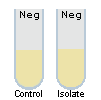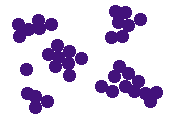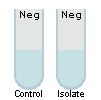Urinary Tract - Bacterial Identification
Laboratory testing algorithm for E. coli, Proteus mirabilis, Providencia stuartii, Serratia marcescens, Enterobacter cloacae, Staphylococcus saprophyticus, and Enterococcus
Hover over the animation to start / stop rotation
Large Gram Negative - - Large Rods
Oxidase Test - Negative
  Enterobacteriaceae Enterobacteriaceae
Large Gram Negative Rods
MacConkey Agar - Positive Lactose
Positive Indole Test - Green sheen on EMB Agar
   Escherichia coli Escherichia coli
Large Gram Negative Rods
MacConkey Agar - Negative Lactose
Swarming Growth on Blood Agar
H 2S positive - - Indole negative
   Proteus mirabilis Proteus mirabilis
Large Gram Negative Rods
MacConkey Agar - Negative Lactose
H 2S negative - - Indole Positive
   Providencia stuartii Providencia stuartii
Large Gram Negative Rods
MacConkey Agar - Negative Lactose
Nutrient Agar Red Pigment - - Citrate positive
   Serratia marcescens Serratia marcescens
Large Gram Negative Rods
MacConkey Agar - Positive Lactose
Indole Negative - - Urea positive
   Enterobacter cloacae Enterobacter cloacae
Gram positive Cocci in Clusters
Catalase Positive - - Coagulase Negative
Novobiocin Test Positive
   Staphylococcus saprophyticus Staphylococcus saprophyticus
Gram positive Cocci in Chains
Catalase Negative
Gamma (no) Hemolysis on Blood Agar
Bile Esculin Agar Positive
   Enterococcus Enterococcus
|
|
Urinary tract infections (UTIs) are common, and most are uncomplicated. Bacteria are the most common organisms implicated, most often the Enterobacteriaceae, and the majority are due to E. coli.
Though many species of bacteria can be implicated in UTIs, the most common are given above.
Uncomplicated UTIs can be treated empirically. Infections that are recurrent or more severe can be assessed with microbiologic culture and antibiotic sensitivity to choose the best treatment.
Since collection of urine for culture by voiding is inherently a nonsterile method with contamination by perineal bacteria, then one criterion for assessment of a true infection is a "colony count" performed using a calibrated loop, with 0.001 mL of the urine sample plated onto culture media and incubated. The number of colonies present is multiplied by 1000. In this example, there are over 100,000 colonies/mL. This number, >105 for one organism, is considered significant. A blood agar plate for colony counting is shown below:
 Antibiotic sensitivity testing with a Kirby-Bauer plate us shown below illustrating the diffusion disk method in which antibiotic-impregnated disks are placed on a culture plate with the organism, and the zone of inhibition of growth is measured, compared to controls. In general, less than 2 mm of inhibition defines resistance, while a large zone of inhibition suggests sensitivity. Smaller zones imply intermediate sensitivity. In the example below, the organism is sensitive to Amikacin and Penicillin, with intermediate sensitivity to Gentamicin and Cefotaxime, with resistance to Methicillin, Vancomycin, and Nafcillin.
|



























